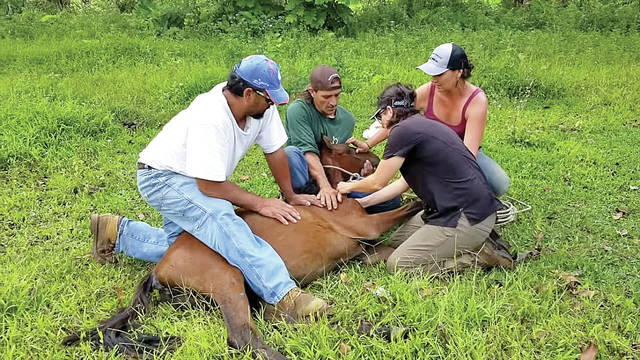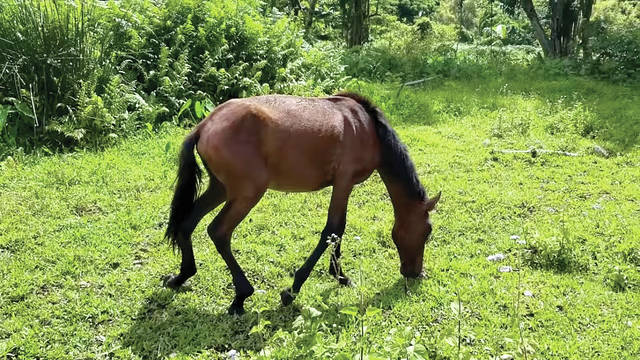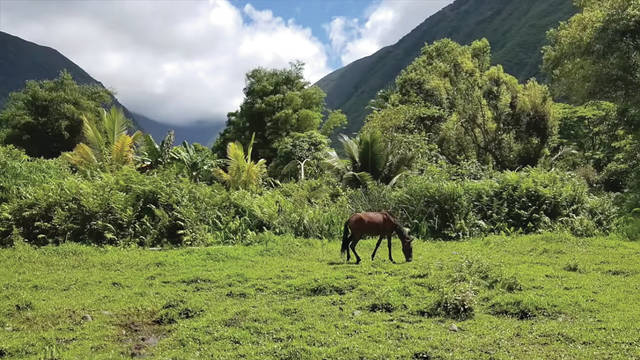KAILUA-KONA — No one knows how many wild horses in Waipio Valley have perished, or what is killing them.
Dr. Tim Richards, Hawaii County councilman and veterinarian, said the problem appears neurological, but no one looking for answers has ever seen a condition manifest in quite the same way before.
“Not like this clinical presentation,” Richards said. “It’s weird.”
Horses first present with an abnormal gait as muscles begin to atrophy, starting with the hind limbs. Eventually, the animals are unable to walk at all.
An effort Richards described as a public/private partnership has put human and monetary resources to bear in an attempt to answer questions surrounding what some familiar with the valley guess has been the death of more than 10 wild horses.
How many horses inhabit the valley is unknown, but guesses generally number at several dozen.
The partnership has made significant progress thus far. The work began with one veterinarian, Dr. Kelleyerin Clabaugh, who was contacted by horseback tour operators concerned about contagion.
With help, Clabaugh trapped two animals and conducted blood tests before releasing the horses. She tested for and ruled out viral encephalitis and the parasitic disease equine protozoal myeloencephalitis.
Clabaugh said if those diseases were found to have made their way across the Pacific, they could “spread like wildfire” through the valley. Her tests also ruled out other contagious diseases like West Nile, neurologic rhinovirus and influenza.
She first heard of the mysterious outbreak between three and four weeks ago and said that as of yet no symptoms have presented among the valley’s domestic horse population, a fact Richards echoed.
While the culprit remains unknown, a form of consensus among investigators does seem to be emerging — that the cause of the unknown illness is correlated with something the horses are eating.
“It most likely looks like a disease caused by mold spore toxins,” Clabaugh said. “That is not a diagnosis, but it is a high suspicion.”
Testing for toxins is the next phase, but that requires a freshly deceased horse from which to sample brain and spinal cord tissue.
No such specimen was procured until Tuesday, when Richards and a team from the Hawaii Department of Agriculture led by Jason Moniz, veterinary program manager for the department’s Animal Disease Control Branch, ventured into the valley.
Moniz said they located a horse resting on its stomach and unable to move. Its back legs were atrophied and the animal appeared depressed and emaciated.
Richards helped conduct a physical exam before it was determined the horse should be euthanized. Pathologists then conducted a complete necropsy on-site.
The animal’s digestive tract was examined and despite its appearance, it was actually well fed, Moniz explained. He noted avocado and several other forms of plant material that were harder to identify.
“These horses that have been affected have been in one area (in the central Kohala side of the valley) and nothing has spread to any of the domestic horses down there, so we’re kind of leaning toward something these animals are consuming,” Moniz said. “There are multiple species of plants down there that have toxic principles.”
He added the general expectation is that plant life in the valley remains relatively static, but farming that disturbs the land, or potentially other factors, could lead to rather immediate changes in flora.
Another consideration is the possibility of human poisoning, although Clabaugh said the evidence collected so far makes that an unlikely possibility.
HDOA sent some tissues to its state lab for histology, while others were shipped to Cornell University, which known for its expertise in equine toxicology work.
Moniz said he expects the full panel of testing to turn around in about three weeks.
Concerns over
rat lungworm
Clabaugh said the momentum behind a notion that the mysterious pathogen is rat lungworm disease has been a product of social media chatter.
“There’s a very big concern in the community that this could be rat lung, but none of the actual professionals in the community think it is,” she said.
The disease, which has become more prevalent on Hawaii Island over the last few years, infecting several people and animals, is low on Clabaugh’s differential list. That’s because “the symptoms don’t really fit.”
Still, Clabaugh and the rest of those working to solve the Waipio Valley mystery are covering all their bases. Brain and spinal cord tissue were required to test for RLD, and now HDOA has them.
Those tests will be conducted by Susan Jarvi, Ph.D., with The Daniel K. Inouye College of Pharmacy at the University of Hawaii at Hilo.
Horses have been known to come down with RLD before.
The disease affects them
in much the same way it affects dogs, a species vets have told Jarvi are contracting RLD more and more frequently.
“We know for a fact horses can get it,” Jarvi said. “I think it’s certainly worth testing.”
Jarvi has done testing on horses treated by Dr. Lisa Wood, Richards’ partner, several of which proved to have RLD. Those horses came from the South Hilo region, Richards said.
Hawaii state Rep. Richard Creagan — of Hawaii Island’s 5th District, which includes portions of Kona and Ka‘u — said RLD manifests similarly in dogs as what is happening to the horses in Waipio. He said their limbs begin to weaken, typically starting with hind limbs, and their tails don’t wag correctly.
Creagan didn’t speculate that the horses were suffering from RLD, but he did say the state needs to do a better job of making the citizenry aware that the disease affects animals and is doing so on a broader and broader scale.
“The (state of Hawaii) health department and the ag department, they’re not telling people about it here,” Creagan asserted. “It’s just crazy.”
Richards said the best thing for everyone to do now is simply to wait until all the results come back, as the effort has procured what it needs to proceed medically.
“I don’t like to discuss what it could possibly be,” Richards said. “We end up going down rabbit holes and that alarms people and scares people, and that’s not the intent.”
He added, however, that evidence related to the mysterious ailment killing wild horses in Waipio Valley doesn’t yet point to a zoonotic concern — an illness that can be passed from animals to the human population.
Confirming that is an important goal of the ongoing testing, Richards said.













